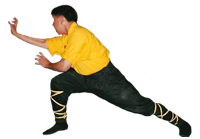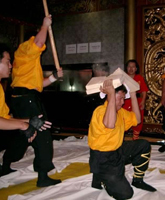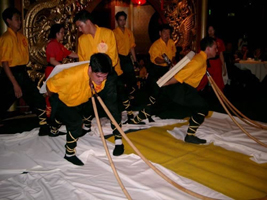Kung Fu
“Kung fu” is the term used to refer to Chinese martial arts, although its true meaning
is “the ability to do something well or readily”. Kung fu incorporates hand-to-hand combat, weaponry,
pressure points, breathing techniques and controlling and manipulating inner strength (or “chi”), making it an
extremely powerful martial art. Besides fitness and health, kung fu can also improve self-confidence, concentration,
balance and co-ordination.
Yarn Yee Tong Kung Fu Acadmey teaches kung fu for personal fitness and health, and for use in
self defense or the defense of others.
The style of kung fu taught at Yarn Yee Tong Kung Fu Academy is Chow Ka (Jow Ga, Chow Ga), a style created by Chow Loong and his four brothers. The Chow Ka style incorporates the best techniques from the Hung Gar, Choy Gar and Buk Siu Lum styles of kung fu, the strengths of each style making up for the weaknesses of the others, emphasising efficient movements, simultaneous attack and defense, and control of both inner and outer strength.
Stances
Stances are the foundation of kung fu, and an extremely important part of the Chow Ka style. Whether you are issuing a punch, a kick, a block, or any other technique, strength is not only generated at the point of contact, but from the ground, through the stance, through the waist and then to the focus point. Training stances also strengthens the legs and improves balance, and it is for all these reasons that all new students begin by practicing stances before moving on to forms. The basic stances are:
- Horse-riding stance
- Forward stance
- Cat stance
- Cross stance
- Knee stance
Hand Forms

A ‘form’ is a predetermined series of movements, intended to simulate a battle and help students practice techniques until they become second nature. Mastering a kung fu form is more than just memorising the movements; each technique needs to have strength, proper stance and correct execution. The length of time that it takes to perfect a form is dependent on the ability of the student.
After learning the stances, new students will begin with Sup Jee Moy Fah Keun (’Ten’ Character Plum Blossom Fist), a short form with basic techniques. Later forms get progressively harder, and require a greater level of concentration and self-discipline.
Weapon Forms
In Chow Ka kung fu, any object can be used as a weapon. Although students train with traditional weapons the techniques used in these forms can be applied to everyday objects, making them useful for self defense outside of training. Some of the weapons used are:
- Surng Tau Gwun (Staff)
- Nau Yip Doe (Broadsword)
- Pau Jung Doe (Butterfly Swords)
- Moy Fah Gim (Plum Blossom Sword)
- Ying Churn (Tassle Spear)
All students are required to have mastered the first two basic hand forms before learning any weapon forms, as they require a certain level of skill and self-discipline.
Sparring and Self Defense Techiniques
Sparring sets are similar to forms in that they are made up of predetermined moves, but are performed with one or more other people. Their purpose is to familiarise students with performing the self defense techniques on a real opponent. Sparring sets can be performed both with and without weapons.
Free sparring aims to improve speed and the ability to predict an opponent’s movements, and react accordingly using techniques practiced in forms and sparring sets. Students may only participate in free sparring after they have demonstrated correct technique and self-control, and only under the supervision of Sifu Quyen or advanced students.
Chi Kung
Chi Kung translates to ‘air achievement’, and is the technique of controling breathe and ‘chi’ (air/life energy) to enable the body to do things beyond its normal capacity. Chi Kung can be used for healing purposes, or used in demonstrations such as bending a spear or steel rods on the throat or the famous Iron Palm and Iron head techniques.





